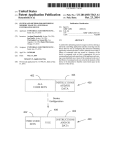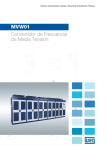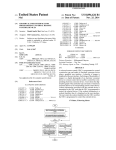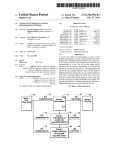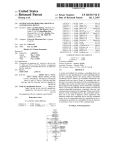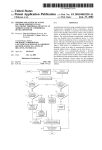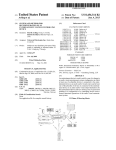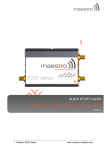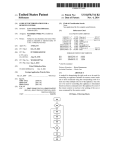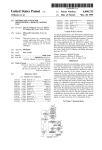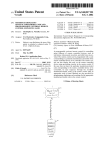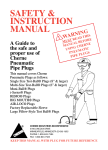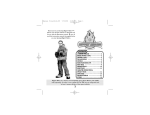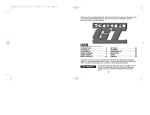Download System and method for simplified setup of a universal remote control
Transcript
US007907222B2
(12) United States Patent
(10) Patent N0.:
(45) Date of Patent:
Haughawout et al.
(54)
SYSTEM AND METHOD FOR SIMPLIFIED
5,552,917
5,614,906
5,889,506
5,959,751
6,008,735
6,014,092
6,127,961
6,211,870
6,344,817
6,650,248
SETUP OF A UNIVERSAL REMOTE
CONTROL
(75) Inventors: Joseph Lee Haughawout, Aliso Vlejo,
CA (US); Steve LanPing Huang,
Placentia, CA (US); Patrick H. Hayes,
Mission Vlejo, CA (US)
(73) Assignee: Universal Electronics Inc., Cypress, CA
(Us)
A
A
A
A
A
A
A
B1
B1
B1
9/2004
Shibamiya .................. .. 348/734
9/2005
Sato ............................ .. 348/734
6,947,101 B2
9/2005 Arling
2002/0158771 A1
2003/0189509 A1
2004/0235463 A1
U.S.C. 154(b) by 1226 days.
WO
WO
WO
WO
WO
WO
Sep. 5, 2006
(65)
Prior Publication Data
US 2007/0052547 A1
3/2006 Masters et al.
12/2006
Gustafson et a1. .......... .. 348/734
10/2002 Mears
10/2003 Hayes et a1.
11/2004 Patel
FOREIGN PATENT DOCUMENTS
(21) App1.No.: 11/515,962
(22) Filed:
Darbee et a1.
Hayes et a1.
Lopresti et al.
Darbee et a1.
Chiloyan et a1.
Darbee et a1.
Stacy et a1.
Foster
Verzulli
O’Donnell et a1.
6,795,130 B2 *
7,154,566 B2 *
Subject to any disclaimer, the term of this
patent is extended or adjusted under 35
Mar. 15, 2011
6,940,562 B2 *
7,013,434 B2
Notice:
9/1996
3/1997
3/1999
9/1999
12/1999
1/2000
10/2000
4/2001
2/2002
11/2003
US 7,907,222 B2
Mar. 8, 2007
97/32290
00/17738
00/39772
01/47130
03/083801
2004/051592
A
A
A
A
9/1997
3/2000
7/2000
6/2001
10/2003
6/2004
* cited by examiner
Related U.S. Application Data
(60) Provisional application No. 60/715,229, ?led on Sep.
8, 2005.
Primary Examiner * J efferey F Harold
Assistant Examiner * Jean W Désir
(74) Attorney, Agent, or Firm * Greenberg Traurig, LLP
(51)
Int. Cl.
H04N 5/44
(57)
(2006.01)
(52)
U.S. Cl. ................... .. 348/734; 348/552; 348/14.05;
(58)
Field of Classi?cation Search ................ .. 348/734,
340/426.13; 340/426.14
348/552, 14.05, 14.04; 340/815.6, 825.75,
340/426.13, 426.14, 825.22; 725/80, 81
appliance and is con?gured to appropriately display interac
See application ?le for complete search history.
(56)
tive instructions and prompts to a user during a user initiated
set up procedure for con?guration of another controllable
device (e.g., DVD, VCR, DVR, etc) available to the user.
Appropriate set up data, generally in the form of command
library codes, is displayed to the user by the interactive
References Cited
U.S. PATENT DOCUMENTS
2
53253313 A
ggrnéggléteglal'
10/1993 Barbee
instruction set and associated programming for entry and trial
'
5,341,166 A *
8/1994
5,481,256 A
1/1996 Darbee et a1.
ABSTRACT
A system and method for enabling set up of a controlling
device capable of controlling a plurality of appliances, via an
interactive instruction set and associated programming. The
programming is accessible by a STB or other controllable
by the user in set up of the desired appliance(s).
Garret a1. ................... .. 725/153
10 Claims, 10 Drawing Sheets
1008
1004
r—A? /—/ g\
01 <5
1010 -—>
Cable
515$ Tv58"? DVD
02
Cable
TV
03
cable
Recelver
DVD
04
Cable
Receiver
Cable
05
TV
TV
ova
06
TV
TV
Cable
07
TV
Receiver
DVD
05
TV
Receiver
Cable
ERIN
Cable
“ms
US. Patent
Mar. 15, 2011
Sheet 1 0110
102
106 j
FIGURE 1
US 7,907,222 B2
US. Patent
Mar. 15, 2011
US 7,907,222 B2
Sheet 2 0f 10
208
303
202
,,/
220
@@
7.
1
208
1 0
214
FIGURE 2
US. Patent
Mar. 15, 2011
Sheet 3 0f 10
US 7,907,222 B2
307
——
-
\T- Batterles
302
II
I
9
(II
Key
g
.
'5
volatile
8
memory
matrlx
Non- / 306
9
.9
\—
E
‘—
|
I
ROM
/ 308
memory
:
Qlock an_d
Crysta|_|_—___ tlmer logo
|
I
301 / +7 K300
FIGURE 3
RAM
memory
310
US. Patent
Mar. 15, 2011
US 7,907,222 B2
Sheet40f10
Device: VCR
Select brand:
Panasonic
RCA
Sony
HEB
410
FIGURE 4
US. Patent
Mar. 15, 2011
Sheet 5 0f 10
US 7,907,222 B2
Device: VCR
Brand: Samsung
Suggested code:
20060
55%
502
FIGURE 5
US. Patent
Mar. 15, 2011
Sheet 6 0f 10
US 7,907,222 B2
602
Device: VCR
Brand: Samsung
Code: 20060
Test: VOL+, VOL OK? — press “setup”
No, press “select” to
try another
FIGURE 6
US. Patent
Mar. 15, 2011
Remote enters
REMOTE
setupmode
US 7,907,222 B2
Sheet 7 0f 10
l
|
CONTROL I
SET TOP
BOX
I
|
|
Remote transmits
“setup” command
_\_ _ _ _ _ l _ _
_ _ _ _ _ _ _‘__\_\_
to STB
I
STB |oads setup
appnca?on
|
I
l
I,
l
y
|
.
I
Remote con?gures
|
"STB dlsplal/s
keyboard for setup
|
seled dfvm
activity
|
type
I
I
I
I
1
U_se' sew“?
|
“we? “(De “5'"9
nav‘gat'on and
'::f ‘ _ "|_ - P
_ _ _ _ _ _ _ _ _\
SELECT keys.
I
|
l
I
STB displays
scrollable list of
brand names for
selected device
type '
I
g
I
User scrolls list
and selects brand
l
|
I
STB displays most
"kely sewp mde
number for that
name
:
device & brand,
I
|
I
Use enters device
i
code number
_: _ _ __ _ __|_ _ >
using numeric pad _ _ _ _ _ __ _‘_\____
F.—
.
STB d'splays
suggested
(signals STB on
l
:
fu"°t'°'3§ '0 {lest
lastdmn)
.
ques?on
l
Il
and QK?
l
|
User tests
I
functions
:
i
I
I
I
I
No
Yes
User presses
“Select”, remote
User presses
_ _ _ _ _ _ _ _ _
transmits that code
to STB
(IR transmission)
__:sr—>
l
I
l
I
r
V
l
“Setup”, remote
transmits
“complete” to STB
YES
STB displays next
most likely setup
i
Key
con?guration
enabled?
_ L: _>
" '
code number for
that device &
brand.
v
_ I
_
Select
2313;? is:
received 7
- —w
Complete or Exit
Key
con?guration
enabled?
Yes
US. Patent
Mar. 15, 2011
Sheet 8 0f 10
US 7,907,222 B2
102
EiiiiIIEE-I
802
Which device do
EHEI
you use lo control
volume?
TV
Audio receiver
VCR
Fig 8a
804
Which device do
you use to play
back movies?
Fig 8b
Which device do
you use to change
channels?
TV
VCR
Fig 8c
FIGURE 8
US. Patent
Mar. 15, 2011
Sheet 9 0f 10
l
US 7,907,222 B2
REMOTE
:
SET TOP
CONTROL
,
BOX
(B)
l
4
'
i
l
v
|
1
Prompt user to
specify volume
I
control device
I
User selects
volume control
i
\ \
device
\
\ ~ \ \
7
I
\‘\~l \
\ c ‘
k
i
‘ \ ‘
l
‘ \‘
I
alid lR code
received?
I
Set volume keys to
indicated device
l
I
<-_—l
l
l
l
:
User selects
playback control
\ \
device
s \
‘\\\
Prompt user to
I
specify playback
l
'
device
|
‘¢+.\
\ \ \ \ \|\
\ \ \
“k \
i
\ \
| ‘\
I
‘s
.
\
and R code
I
received?
Set playback keys
:
to indicated device
I
I
l
902
STB remote?
904
:
pplication
'
|
resident in
STB?
:
I
N
i
i
v
Channel tuning
gse' Slewch
device = STE
c anne_tun|ng
devrce
~ ‘
~
‘ \ \
\ \
:
Prompt user to
|
specify channel
I
tumng device
|
x
\ \
i
device
906
‘
i
\\ \ l
\ T \
\ \
Set channel tuning
keys to indicated
Y
\
\ \
I
|
1
i
\
alld Ii? code
reserved?
:
i
i
.
I
Adjust macro
sequences to
match devices
selected
|
|
I
I
l
(IR transmission)
l
I
I
l
*r — —)
FIGURE 9
US. Patent
Mar. 15, 2011
r
1008
A
:
!
\K
Q o)
gob
US 7,907,222 B2
1004
A
a
q,
1010 €
Sheet 10 0f 10
é? 'é“
0 '9
x
w
5
s \
q; \
9°8$0
5 $0
Q\ 8
01
Cable
TV
DVD
02
Cable
TV
Cable
03
Cable
Receiver
DVD
04
Cable
Receiver
Cable
05
TV
TV
DVD
06
TV
TV
Cable
07
TV
Receiver
DVD
08
Tv
Receiver
Cable
Etc..
1006
:
:
:
l
'
5
l
I
1002
FIGURE 10
US 7,907,222 B2
1
2
SYSTEM AND METHOD FOR SIMPLIFIED
SETUP OF A UNIVERSAL REMOTE
CONTROL
friendly system and method for manually setting up and con
?guring a universal remote control.
SUMMARY OF THE INVENTION
RELATED APPLICATION DATA
In accordance with this need, the following describes a
system and method for allowing a universal remote control to
This application claims the bene?t of US. Provisional
Application Ser. No. 60/715,229 ?led on Sep. 8, 2005 which
be easily setup and con?gured to command appliances of
application is incorporated herein by reference in its entirety.
various types and various manufacturers.
A better appreciation of the objects, advantages, features,
properties, and relationships of the system and method for
BACKGROUND OF THE INVENTION
setting up and con?guring a universal remote control will be
obtained from the following detailed description and accom
panying drawings which set forth illustrative embodiments
which are indicative of the various ways in which the prin
ciples of the system and method may be employed.
This invention relates generally to remote control systems
and, more particularly, to a system and method for setting up
and con?guring a universal remote control to command func
tions of one or more types of remotely controllable appliances
of one or more manufacturers. Exemplary types of appliances
include, but are not limited to televisions, video cassette
recorders (VCRs), cable boxes, disk players, digital video
BRIEF DESCRIPTION OF THE DRAWINGS
20
recorders (DVRs), thermostats, game consoles, etc.
Manufacturers typically provide a remote control with an
25
described hereinafter, reference may be had to preferred
embodiments shown in the following drawings in which:
FIG. 1 illustrates an exemplary system in which the uni
versal remote control may be used;
30
FIG. 2 illustrates a top view of an exemplary universal
remote control for use in the system of FIG. 1;
FIG. 3 illustrates a block diagram view of various compo
nents of the exemplary universal remote control of FIG. 2;
FIGS. 4 through 6 illustrate the system of FIG. 1 at various
appliance and, as such, different appliance types of different
manufacturers are often commanded with different remote
controls. To minimize the number of individual remote con
trols a user requires, universal remote controls have been
developed. Accordingly, universal remote controls for com
manding various functions of various types of appliances of
various manufacturers have become quite widespread. By
way of example, universal remote controls are described in
For use in better understanding the exemplary systems and
methods for setting up a universal remote control which are
commonly assigned US. Pat. Nos. 4,959,810, 5,255,313 and
stages during initial setup of the exemplary universal remote
5,552,917.
control;
In a common method of setting up a universal remote
control, codes for commanding functions of an appliance are
learned from a remote control supplied by the manufacturer
with that appliance. The learned codes, which are stored
within the universal remote control, are then available for
FIG. 7 illustrates, in ?ow chart form, the steps performed
during initial setup of the exemplary universal remote con
35
FIG. 8 illustrates the system of FIG. 1 at various stages
during an exemplary key mapping setup of the exemplary
subsequent transmission to the appliance. Alternatively,
codes for commanding functions of appliances of various
types and various manufacturers can be preprogrammed into
trol;
remote control;
FIG. 9 illustrates, in ?ow chart form, the steps performed
40
during key mapping setup of the exemplary remote control;
the universal remote control. The user then interacts with the
universal remote control to identify to the universal remote
and
control which appliance(s) the user desires to command, i.e.,
the user manually enters an appliance or brand code, usually
alternate method for key mapping setup of a remote control.
obtained from a tabulation in a printed user manual or the like,
into the universal remote control and the universal remote
control uses that user provided identity information to access
those preprogrammed codes that are appropriate for com
FIG. 10 illustrates an instruction sheet for an exemplary
45
The following describes a system and methods for setting
up and con?guring a universal remote control to command
manding the identi?ed appliance(s). In this regard, examples
of known methods for performing an initial setup of an uni
one or more functions of one or more types of appliances of
50
versal remote control may be found in, for example, the above
illustrated as a TV set 104 and a VCR 106.
55
ity,” each of which is incorporated herein by reference in its
entirety.
An additional system and method for setting up a universal
remote control is disclosed in US. Pat. No. 6,650,248.
While known setup methods do work for their intended
purpose, it has been seen that the process of setting up and
con?guring a universal remote control can be demanding,
60
exacting, and generally frustrating for many users. For
example, user manuals or other documents containing setup
codes and entry instructions may be lost or misplaced, or may
be superseded as brand and/or model names evolve, etc.
Accordingly, a need exists for a simpli?ed and more user
one or more manufacturers. By way of example, FIG. 1 illus
trates an exemplary system 110 wherein a universal remote
control 100 supplied together with a cable set top box 102
may be used to command functions of various appliances,
mentioned US. Pat. No. 4,959,810 as well as US. Pat. No.
5,614,906, entitled “Method for Selecting a Remote Control
Command Set,” or US. Pat. No. 4,703,359 entitled “Univer
sal Remote Control Unit with Model Identi?cation Capabil
DESCRIPTION OF THE INVENTION
65
For use in remotely commanding a device to perform a
common and/or extended operational function (i.e., a func
tion that may not be widely supported by devices of a com
mon device type), the universal remote control 100, an
example of which is illustrated in FIG. 2, includes a set of
command keys within a key matrix which are assigned to
operational functions. In this regard, common operational
functions include functions that are usually widely supported
by devices of a common device type (e.g., power 202, digit
tuning 204, volume control 208, channel up/down control
206, media transport 210, etc.) The universal remote control
100 also includes device keys 212, e.g., “AUX,” “CBL,”
“VCR,” and “TV,” the activation of whichplaces the universal
US 7,907,222 B2
3
4
remote control 100 into a mode to transmit commands to a
satellite set top box (“STB”) 102. Remote control 100 may
particular type of device, and a setup key 208. It will be
appreciated that, while illustrated as hard keys, the keys of the
trolling other types of appliances which are commonly uti
include a universal library of infrared codes for use in con
universal remote control 100 may implemented as soft keys,
for example, by being displayed on an LCD touch screen or
the like.
lized in conjunction with a set top box, such as for example a
TV 104 and/or a VCR 106. To facilitate setting up remote
sal remote control 100 may include, as needed for a particular
control 100 to command operation of appliances 104, 106,
STB 102 may be equipped with data 404 and application
program 406, preferably stored locally within STB 102 on
application, a processor 300 coupled to one or more memory
mass storage 402 or on a device otherwise accessible to STB
By way of further example, referring to FIG. 3, the univer
devices (such as a ROM memory 308, a RAM memory 310,
102. It will be appreciated that mass storage 402 may take the
form of ?ash memory, ROM memory, RAM memory,
memory card or stick, hard disk drive, CD ROM, etc., or any
combination of the above as appropriate. It will be further
and/or non-volatile read/write memory 306), a key matrix
302 (e.g., physical buttons, a touch screen display, or a com
bination thereof), an internal clock and timer 301, transmis
sion circuit(s) 304 (e.g., IR and/or RF), receiver circuit(s)
appreciated that data 404 and application 402 may be peri
and/or transceiver circuit(s) (e.g., IR and/or RFinot illus
odically updated over the cable network and/or may in certain
embodiments even be partially or fully resident at the cable
head end or other remote source accessible by STB 102. The
trated), a means 303 to provide visual feedback to the con
sumer (e.g, LED, display, and/or the like), means to provide
audio feedback to the user (e.g., a speakerinot illustrated), a
power supply 307, and/or a serial I/O port (e.g., a jack or
contactsinot illustrated). As will be understood by those of
skill in the art, the memory device(s) includes executable
instructions that are intended to be executed by the processor
300 to control the operation of the universal remote control
100. In this manner, the processor 100 may be programmed to
control the various electronic components within the univer
sal remote control 100, e. g., to monitor the power supply 307,
to cause the transmission of signals, display icons and/or
HTML pages, etc. The non-volatile read/write memory 306,
for example, an EEPROM or the like, may be provided to
store setup data and parameters as necessary such that data is
not required to be reloaded after battery changes. It is to be
understood that the memory devices may take the form of any
type of readable media, such as, for example, a Smart Card,
memory stick, a chip, a hard disk, a magnetic disk, and/or an
optical disk. Still further, it will be appreciated that some or all
of the illustrated memory devices may be physically incor
porated within the same IC chip as the microprocessor 300 (a
so called “microcontroller”) and, as such, they are shown
20
and application 402 are maintained on removable memory,
the removable memory may be updated via a personal com
puter or other device with an Internet connection and then
25
30
35
be signaled to a user by the LED 303 blinking twice (e.g.,
40
transmits a speci?c “setup” IR code to STB 102 which is
interpreted as a command to initiate the “Remote Setup/
Help” application 406. Alternatively or as a backup, in certain
embodiments application 406 may also be invoked from STB
45
key on the STB 102, etc.
responsive to events, such as a sensed consumer interaction
102’s built-in menu system, upon activation of a dedicated
In connection with entering the setup mode, the remote
control 100 may con?gure its keyboard as follows:
Navigation (Left, Right, Up, Down and Select/OK keys)
214, Exit key 216, and device keys 212 are adapted to
50
Digit entry keys 204 do not transmit commands but serve
instructions within the memory devices can be used not only
to cause the transmission of command codes and/or data to
the devices but also to perform local operations. While not
55
versal remote control 100 include displaying information/
data, favorite channel setup, macro button setup, command
only for input of appliance setup codes as described
hereafter; and
Function keys such as volume 208, channel up/down 206,
transport keys 210, etc. are adapted to cause transmis
sion of infrared command data in the format of the
appliance under test as described hereafter.
In connection with the following paragraphs, the reader
60
may wish to refer to FIG. 7 which presents, in ?owchart form,
a summary of the steps described below and illustrated in
FIGS. 4 through 6. Upon initiation, STB application 406 may
access the operational functions of a device, the consumer
may use an improved system and method for obtaining, enter
ing, and testing device code information, one exemplary
embodiment of which is described hereafter.
Turning now to FIG. 4, in an exemplary embodiment a
remote control 100 may be supplied together with a cable or
cause transmission of infrared command data in the
format recognized by STB 102;
recognizable by the device. It will be appreciated that the
function key relocation, etc. Since examples of local opera
tions canbe foundinU.S. Pat. Nos. 5,481,256, 5,959,751, and
6,014,092 they will not be discussed in greater detail herein.
To initially program the universal remote control 100 to
The user enters a Setup Mode by, for example, pressing and
holding setup key 208. The entering of the Setup Mode may
upon pressing and holding the setup key for approximately 3
seconds). Upon entering Setup Mode the remote control
with the key matrix 302, receipt of a transmission, etc. In
limiting, local operations that may be performed by the uni
of interactions between a remote control 100 and an applica
tion 402 resident in an STB, in alternative embodiments
application 402 may be hosted on, and the interactions may
occur with, any suitable appliance such as a TV, DVR, AV
receiver, etc. without limitation.
Application 406 is responsive to IR signals issued by
action, the universal remote control 100 is adapted to be
response to an event appropriate instructions and/or data
within the memory devices are executed and/or accessed. For
example, when a command key is activated on the universal
remote control 100, the universal remote control 100 may
retrieve a code data value corresponding to the activated
command key from a memory device and access instructions
to transmit the retrieved code data value to a device in a format
replaced into the STB 102. It should also be appreciated that
while the exemplary embodiment below is presented in terms
remote control 100 during the user setup process as illustrated
in the ?owchart of FIG. 7 and described below:
separately in FIG. 3 only for the sake of clarity.
To cause the universal remote control 100 to perform an
data 404 and application 402 may also be updated using a
device other than the STB 102. For example, if the data 404
65
display on TV 104 a user prompt such as for example: “What
device do you want to setup for control?” together with a list
of valid device types, e. g. “TV”, “VCR”, “Receiver”, etc. The
application 406 may also prompt the user to select an appro
priate language for the prompts. Application 406 may addi
US 7,907,222 B2
5
6
tionally display messages for general user guidance such as
activating the “setup” or “exit” key, or alternatively, data 404
for example “Press Exit at any time to exit remote setup and
return to watching TV.”
In the exemplary embodiment the user may then select,
may include an indicator that no further possibilities exist,
upon eventual retrieval of which application 406 may cause a
using navigation keys 214, a desired device type from the
displayed list, for example “VCR.” In an alternative embodi
ment, the user may directly select the device type by actuating
pressing the “exit” key and, for example, call a customer
service number. In an alternate embodiment, application 406
may be con?gured to monitor command data transmitted
display of instructions to the user to abort the setup process by
from remote control 100 during the setup process for use in
one of the device keys 212 of the remote control, which may
in that instance be adapted to transmit a signal to the STB
indicative of the device type selected. Application 406 may
respond by displaying a con?rmation of the selected device
automatically progressing through the various setup instruc
tions and prompts associated with the setup application. By
way of example only, application 406 may be con?gured to
type together with scrollable list 410 of valid brand names for
monitor command data transmitted from remote control 100
that device type, as illustrated in FIG. 4. The brand names that
in order to echo key presses on the TV screen as a means of
visual veri?cation to the user that a setup code was entered
comprise this list are obtained by reference to data ?le 404. In
this way it will be understood that certain keys or groups of
keys on remote control 100 may be temporarily recon?gured
correctly, or to present prompts such as “Did your DVD
player respond to the Power On command? Press “1” for yes,
or press “0” for no” whereupon receipt of either the “l” or “0”
key command data will cause application 406 to proceed
automatically to another instruction or prompt in the setup
(generally during the setup procedure) to transmit command
data to STB for purposes of user interaction with application
406 during the setup process.
The user may then select (once again via use of keys 214)
a desired brand name, for example “Samsung.” Application
406 may respond by displaying the remote control setup code
20
In certain embodiments, after the appropriate command
code sets for the devices to be controlled have been selected as
number most likely to result in selection of an infrared code
set which will operate appliances of the type and manufacture
indicated (once again, obtained by reference to data 404). In
the exemplary embodiment presented, this number may
25
30
via one of the keys 212, this may not be necessary.
The user may then enter this number, for example “2” “0”
digit entry keys 204. Upon entry of the ?nal digit of the
Pat. No. 6,947,101) or this may take the form of a separate
35
Con?gures itself to transmit commands in the indicated
infrared command format in response to actuation of
function keys 206, 208, 210, etc., and
Transmits an infrared command in STB format to notify
the STB application 406 that device code entry is com
40
Upon receipt of the completion signal from remote control
100, STB application 406 may display a listing of suggested
function(s) 602 to test operation of the target appliance using
45
corresponding operations of the STB (it will be appreciated
may already be factory pre-con?gured in this manner, how
50
mand operation of the appliance, remote control 100 again
transmits a completion signal in STB infrared format, which
406 may interactively prompt the user to enter information
55
Likewise, remote control 100 also returns to normal opera
tion, con?gured now to issue commands in the chosen format
This setup process may continue until the user ?nally exits by
regarding device usage and system con?guration, which
information may then be used to con?gure key assignments,
automatically program macro command sequences such as
“all on”, “all off”, “watch a movie”, etc., or for any other
appropriate remote control con?guration purpose. An exem
that device type (VCR in the example presented) is selected
that the user may repeat the test steps using this new code.
ever remote controls offered as aftermarket accessories and/
or supplied together with other appliances may not be.)
To this end, upon completion of device setup, application
is interpreted by application 406 in STB 102 as a successful
conclusion of the setup process and causes application 406 to
by activation of one of keys 212.
If on the other hand, the user activates the “select” key,
indicative that the current code being tested is unable to
command operation of the appliance, remote control 100
transmits the “select” command signal in STB infrared for
mat, which causes application 406 to retrieve and display the
next most likely setup code number contained in data 404, so
ing operations of the receiver (i.e., the device code setup on
the AUX mode key 220). Cable or satellite subscribers may
wish to have the channel tuning keys 206 and numeric pad
204 always transmit commands that are intended to control
that remote controls which are supplied together with a STB
If the user activates the “setup” key, indicative that the
terminate execution, returning STB 100 to normal operation.
example, users whose equipment is con?gured to route all
audio signals through their a/v receiver may wish to have the
volume keys 208 of exemplary remote control 100 always
transmit commands that are intended to control correspond
press “select” to try a different code, all as illustrated in FIG.
6.
current code being tested has been found suitable to com
special page or device mode (e.g. “Home Theater mode”)
comprised of a composite of groups of key functions from
other device modes (as described in the aforementioned US.
Pat. No. 7,013,434), or some combination thereof. For
plete.
the code just entered, together with a user message to, for
example, press “setup” if the suggested code works, or to
to assign certain subsets of the keys of remote control 100 to
always transmit command codes corresponding to a speci?c
device. As appropriate for a particular embodiment, this may
take the form of a ?xed assignment of certain keys to always
send the same code regardless of the device currently selected
via device keys 212 (as described in the aforementioned US.
“0” “6” “0” (502 in FIG. 5), into remote control 100 using
sequence, remote control 100:
described above, it may be desirable to further con?gure
certain operational characteristics of remote control 100. In
particular, as described for example in US. Pat. No. 6,947,
101 or 7,013,434 (both of like assignee and incorporated
herein by reference in their entirety) it may be advantageous
include a leading digit to indicate to the remote control pro
gramming which device type is to be setup, e. g. “2” for
“VCR”. In alternative embodiments where the user may
already have explicitly entered the device type being set up
procedure.
plary method for performing key mapping is illustrated in
60
FIG. 8 and summarized in ?owchart form in FIG. 9. By way
of this example, upon initiation of this particular setup opera
tion, which may be initiated in a manner similar to that
described above, application 406 may display on TV 104 a
message 802 requesting that the user indicate to the remote
65
control which device is normally used for controlling system
volume. In the example presented, the choices 803 are TV,
audio receiver, or VCR. Without limitation, this list may
US 7,907,222 B2
7
8
include all device types supporting the operation for which is
setup is desired, be limited to those device types that the
system has learned, through the initial con?guration process,
example based on user response to an initial screen displaying
images of the various remote control versions.
While speci?c embodiments of the present invention have
are to be controlled via the remote control, etc. The user may
been described in detail, it will be appreciated by those skilled
then indicate to the remote control which of the listed devices
in the art that various modi?cations and alternatives to those
is to be used for this operation by activation of an appropriate
one of the device keys 212 (“TV”, “Aux” or “VCR” in this
instance). Activation of a device key may then cause the
remote control 100 to set it’s internal key mapping for volume
details could be developed in light of the overall teachings of
the disclosure. For example, it should be appreciated that any
control (i.e., the command codes which are to be transmitted
noted, the functionality of the universal remote control 100
of the above described methods can be used alone or in
combination to setup the remote control 100. Additionally, as
by the volume and mute keys 208 during normal operation) to
can be included in other controlling devices such as PDAs,
match the device indicated. Remote control 100 may also
transmit a speci?c command code to STE 102 indicating that
a volume selection has been made. Receipt of this command
by the STB may cause application 406 to display the next user
prompt 804 on TV 104, requesting user selection of the device
usually used for movie playback. In a similar manner, a user
personal computers, home devices, or the like. Further, while
the exemplary embodiment above is presented in terms of
interactions between a set top box and a universal remote
control, it will be appreciated that many other appliance
types, e.g. TVs, PVRs, DVDs, PCs, etc. may be substituted
for the STB without altering the spirit of the invention.
Accordingly, it will be understood that the particular arrange
selection of playback device may be performed. With refer
ence to the ?owchart of FIG. 9 (902,904), in systems where
remote control 100 was supplied in conjunction with STE
20
only and not limiting as to the scope of the invention which is
to be given the full breadth of the appended claims and any
102 and application 406 is resident in the STB, the step of
selecting a channel tuning device may be bypassed since in
this instance it is the STB by default. In other situations, the
user may be prompted 806 to specify a device to be used for
channel tuning, once again in a similar manner to that previ
equivalents thereof.
All of the cited patents and patent applications are hereby
25
ously described. Upon completion of this stage of the setup
process, in certain embodiments remote control 100 may also
adjust 906 macro command sequences (such as “all on” or
“all off”, or activity initiating macros such as “watch a
30
are activatable to enter a single code used to cause the
35
controlling device to both: I) automatically assign com
mands stored within the controlling device and associ
ated with a ?rst device type mapped within the control
ling device to the single code entered to a ?rst
support additional applications is still in use, etc.) an alterna
tive method of con?guring key mapping assignments may be
40
predetermined group of the plurality of function keys
and; 2) automatically assign commands stored within
the controlling device and associated with a second
device type mapped within the controlling device to the
table 1002 made available to the user of remote control 100
single code entered to a second predetermined group of
the plurality of function keys,
45
wherein the ?rst device type is different than the second
device type and the ?rst predetermined group of the
plurality of function keys is different than the second
predetermined group of the plurality of function keys.
users of remote control 100 may be instructed to invoke a
special setup mode (e.g. by activating a speci?c sequence of
keys on remote control 100) and then input the indicated
identi?cation data for their system con?guration. For
receiving input into the controlling device which functions
to place the controlling device into a setup mode where
con?guration is being performed prior to the equipment being
for example by publication in the user manual, posting on a
Web site, etc. Table 1002 may comprise a matrix listing key
groups 1004 together with possible permutations 1006 and an
identi?er 1008 for each (e.g., a number). In this example,
plurality of function keys, comprising:
upon one or more keys of the plurality of function keys
hooked up, where an earlier generation STB which does not
offered either in place of or in conjunction with the methods
presented above. This may take the form of a con?guration
incorporated by reference in their entirety.
What is claimed is:
1. A method for con?guring a controlling device having a
movie”) as required by the newly-entered device preferences.
Turning now to FIG. 10, in certain embodiments where
application 406 is not available to or is not supported by the
STB and/or a display device such as TV 104 is not readily
available (for example, in instances where the remote control
ments and procedures disclosed are meant to be illustrative
50
2. The method as recited in claim 1, comprising creating a
con?guration table which functions to map different codes
example, in the embodiment illustrated in FIG. 1 0, a user who
enterable in the setup mode to corresponding permutations of
changes channels via a cable STB, routes his audio signals
types of devices to be controlled upon activation of the ?rst
through an AV receiver, and uses a DVD player to watch
movies may enter code “0”,“3”, corresponding to the con
predetermined group of the plurality of function keys and the
second predetermined group of the plurality of function keys,
?guration represented by row 1010 of the illustrated table.
55
the art, either as a periodic update or on demand when the
remote control setup feature is invoked. In this manner, the
60
predetermined group of the plurality of function keys com
prise volume control function keys and the second predeter
mined group of the plurality of function keys comprise chan
nel tuning control function keys.
data used to guide the user through the setup process may be
4. The method as recited in claim 1, wherein the ?rst
refreshed whenever new or revised brand names or cross
references occur, to allow for language expansion, etc. Fur
ther, in situations where multiple remote control models or
revisions have been offered by a supplier of the STB or other
host device, alternative data sets 404 may be downloaded, for
the con?guration table to be used as a guide to instruct a user
as to which of the plurality of function keys to activate within
the setup mode to achieve a desired con?guration result.
3. The method as recited in claim 1, wherein the ?rst
It will be appreciated that all or part of data 404 and/or
application 406 may be downloaded into STE 102 (or other
application host device as appropriate) from a cable or satel
lite headend, the intemet, the PSTN, etc., as is well known in
65
predetermined group of the plurality of function keys com
prise volume control function keys and the second predeter
mined group of the plurality of function keys comprise play
back control function keys.
US 7,907,222 B2
10
8. The method as recited in claim 1, Wherein the ?rst device
type comprises a television and the second device type com
5. The method as recited in claim 1, Wherein the ?rst
predetermined group of the plurality of function keys com
prise playback control function keys and the second prede
termined group of the plurality of function keys comprise
channel tuning control function keys.
6. The method as recited in claim 1, Wherein the one or
more keys of the plurality of function keys activatable to enter
the single code comprises at least one key having a numerical
label.
7. The method as recited in claim 1, Wherein the ?rst device
type comprises a television and the second device type com
prises a set-top box.
prises a video disc player.
5
9. The method as recited in claim 1, Wherein the ?rst device
type comprises an audio receiver and the second device type
comprises a video disc player.
10. The method as recited in claim 1, Wherein the ?rst
device type comprises a television and the second device type
comprises an audio receiver.
UNITED STATES PATENT AND TRADEMARK OFFICE
CERTIFICATE OF CORRECTION
PATENT NO.
I 7,907,222 B2
APPLICATION NO.
DATED
: 11/515962
: March 15, 2011
INVENTOR(S)
: Steve LanPing Huang and Patrick H. Hayes
Page 1 ofl
It is certified that error appears in the above-identi?ed patent and that said Letters Patent is hereby corrected as shown below:
Cover Page:
(75) Inventors: delete inventor “Joseph Lee Haughawout”
Signed and Sealed this
Eighteenth Day of September, 2012
v
David J. Kappos
Director 0fthe United States Patent and Trademark O?ice

















